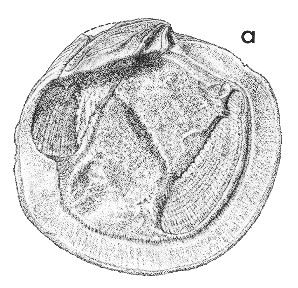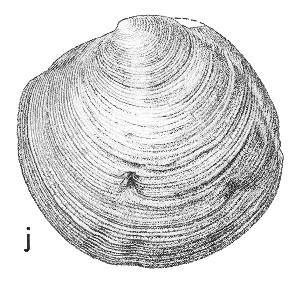
Revised descriptions of New Zealand Cenozoic Mollusca from Beu and Maxwell (1990)

 | Revised descriptions of New Zealand Cenozoic Mollusca from Beu and Maxwell (1990) | 
|
  (Pl. 35a): Whakino, South Taranaki, Waipipian, a large specimen from Marshall and Murdoch Collection (GNS) |
  (Pl. 35j): Whakino, South Taranaki, Waipipian, a large specimen from Marshall and Murdoch Collection (GNS) |
Beu & Maxwell (1990): Chapter 14; p. 281; pl. 35 a, j.
Synonymy: Miltha neozelanica Marshall and Murdoch 1921, p. 78; Miltha dosiniformis Marshall and Murdoch 1921, p. 79; Miltha (Milthoidea) neozelanica; Miltha (Milthoidea) dosiniformis
Type species of Milthoidea Marwick, 1931 (= Miltha H. & A. Adams, 1857)
Classification: Lucinidae
Description: Very large for family (47-97 mm high), discoidal and weakly inflated, almost circular, thick and solid. Sculpture of weak commarginal grooves and, on some specimens, low, very thin commarginal lamellae; a weakly defined, shallow groove and low fold define a narrow, slightly raised posterior area and a very weak groove defines a small anterior area, on both of which the commarginal lamellae are more consistently developed than elsewhere. Lunule a small, triangular, deeply excavated area, 0.5-0.7 width of hinge plate, just in front of and, in some specimens, partially obliterating anterior cardinal tooth. Hinge plate wide, with a straight lower margin, fused to disc (i.e., without umbonal hollow), with 2 narrow, curved cardinal teeth in each valve, but no lateral teeth; most of hinge plate, behind teeth, occupied by a long, smooth ligamental nymph and a wide, shallow, deeply sunken ligamental groove completely inside valve margin. Anterior adductor scar enormous, tall and relatively narrow, extending to centre of ventral margin of disc, situated immediately inside pallial line; posterior adductor scar much smaller, oval; pallial line without sinus. Central area bounded by muscle scars and pallial line consistently roughened and papillose, with a deep, almost vertical, central groove in most specimens.
Comparison: New Zealand Cenozoic specimens of Miltha are quite variable in relative inflation of the two valves (most specimens are symmetrical, but the left or right valve may be more inflated than the other), prominence of angulations in the anterior and posterior outline, width and prominence of the anterior and posterior "wings", and prominence of commarginal sculpture; we are unable to distinguish M. dosiniformis from M. neozelanica. A lot of five specimens from Brydone, Mataura River, Southland (Waitakian) agrees exactly with Waipipi shells in all characters. A lot of nine specimens, from Waihao River near "Pentland Hills" Station, South Canterbury (Bortonian), is consistently small (to 45 mm high), with a wide posterior wing and relatively prominent commarginal lamellae, and appears to be the one New Zealand lot that represents a species distinct from M. neozelanica (apart from the poorly known M. agilis, Wangaloan). Beu & Maxwell (1990) selected M. neozelanica as the name for the species named both M. neozelanica and M. dosiniformis by Marshall & Murdoch (1921). We agree with Ludbrook (1969) that there are no characters separating Milthoidea Marwick, 1931 from Miltha (sensu stricto).
Distribution: Whaingaroan-Waipipian; Waipipi Shellbeds, Waverley Beach, west of Wanganui, Waipipian (type of M. neozelanica); Kawau Island, Auckland, Otaian (type of M. dosiniformis). Miltha neozelanica occurs rarely and sporadically throughout New Zealand Oligocene and Neogene rocks, as young as Waipipian, in shallow, nearshore facies (mostly shellbeds) in soft substrates; most specimens we have seen are from Waverley Beach (Waipipian) but it is rare even there.
Cite this publication as: "A.G. Beu and J.I. Raine (2009). Revised
descriptions of New Zealand Cenozoic Mollusca from Beu and Maxwell (1990). GNS
Science miscellaneous series no. 27."
© GNS Science, 2009
ISBN
978-0-478-19705-1
ISSN 1177-2441
(Included with a PDF facsimile file
copy of New Zealand Geological Survey Paleontological Bulletin 58 in CD version
from: Publications Officer, GNS Science, P.O. Box 30368 Lower Hutt, New
Zealand)